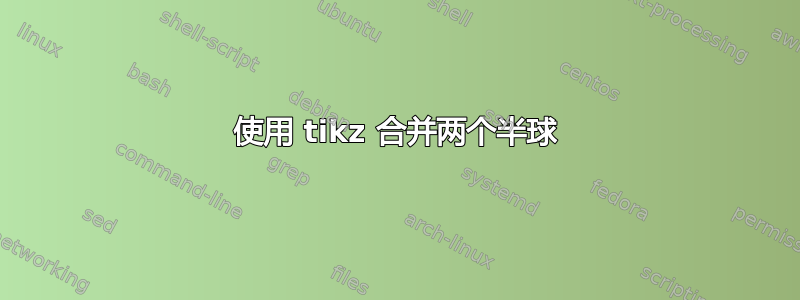
我正在尝试使用 tikz 重现这个复杂的图形:它由两个合并的半球组成,如下所示:

我不知道这在乳胶中是否真的很难,但我试图从这个网站以前的帖子中启发自己,比如这个代码:
\documentclass[margin=10pt]{standalone}
\usepackage{tikz}
\usepackage{tikz-3dplot}
\begin{document}
\tdplotsetmaincoords{60}{110}
%define polar coordinates for some vector
%TODO: look into using 3d spherical coordinate system
\pgfmathsetmacro{\radius}{1}
\pgfmathsetmacro{\thetavec}{0}
\pgfmathsetmacro{\phivec}{0}
%start tikz picture, and use the tdplot_main_coords style to implement the display
%coordinate transformation provided by 3dplot
\begin{tikzpicture}[scale=5,tdplot_main_coords]
%draw the main coordinate system axes
\draw[thick,->] (0,0,0) -- (-1,0,0) node[anchor=south]{$z$};
\draw[thick,->] (0,0,0) -- (0,1,0) node[anchor=north west]{$x$};
\draw[thick,->] (0,0,0) -- (0,0,1) node[anchor=south]{$y$};
\tdplotsetthetaplanecoords{\phivec}
%draw some dashed arcs, demonstrating direct arc drawing
\draw[dashed,tdplot_rotated_coords] (\radius,0,0) arc (0:90:\radius);
\draw[dashed] (\radius,0,0) arc (0:360:\radius);
\shade[ball color=blue!10!white,opacity=0.2] (1cm,0) arc (0:-180:1cm and 5mm) arc (180:0:1cm and 1cm);
% (-z x y)
\draw (0, 1, 0) node [circle, fill=blue, inner sep=.02cm] () {};
\draw (0, 0, 1) node [circle, fill=green, inner sep=.02cm] () {};
\draw (-1, 0, 0) node [circle, fill=red, inner sep=.02cm] () {};
\end{tikzpicture}
\end{document}
但我无法在两侧重现这个图形,然后获得半球之间的合并区域对我来说似乎是不可能的......
有人能提供一些技巧来完成这个复杂的任务吗?
提前感谢您的指示,
此致。
答案1
我不确定你到底想实现什么,但是你的第一个图形的简单草图(使用半球体)可以借助 Ti钾Z 库3d和perspective。isometric view您需要计算几个尺寸(相交曲线的角度和半径)。
像这样;
\documentclass[tikz,border=1.618mm]{standalone}
\usetikzlibrary{3d,perspective}
\tikzset{hemisphere/.style={#1,shading=ball,ball color=#1,fill opacity=0.75}}
\begin{document}
\begin{tikzpicture}[isometric view,rotate around z=-90,line cap=round,line join=round]
% some dimensions
\pgfmathsetmacro\r{1} % radius
\pgfmathsetmacro\d{1.9} % distance between centers
\pgfmathsetmacro\a{acos(\d/(2*\r)} % angle
\pgfmathsetmacro\jr{sqrt(\r*\r-0.25*\d*\d)} % join radius
% x-axis and centers
\draw[canvas is xy plane at z=0,scale=1.5,fill=gray!15] (-\r,-\r) rectangle (\d+\r,\r);
\draw[-latex] (0,0) -- (3.5*\r,0) node[right] {$x$};
\foreach\i in {0,1}
\fill (\i*\d,0) circle (0.2mm);
% blue hemisphere
\draw[blue] (225:\r) arc (225:45:\r);
\draw[hemisphere=blue] (225:\r) arc (225:360-\a:\r)
{[canvas is yz plane at x=0.5*\d] arc (180:0:\jr)} arc (\a:45:\r) arc (0:180:\r cm);
% red hemisphere
\draw[red] (\d,0) ++ (225:\r) arc (225:180+\a:\r)
{[canvas is yz plane at x=0.5*\d] arc (180:0:\jr)} arc (180-\a:45:\r);
\draw[hemisphere=red] (\d,0) ++ (225:\r) arc (225:405:\r) arc (0:180:\r cm);
\end{tikzpicture}
\end{document}




